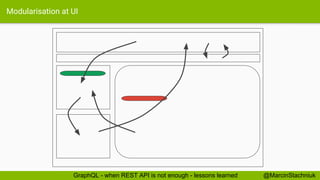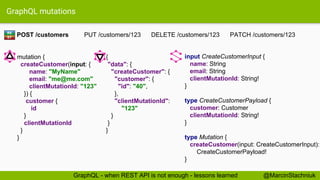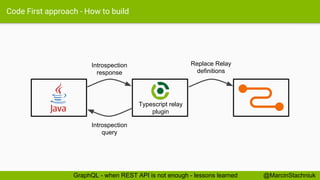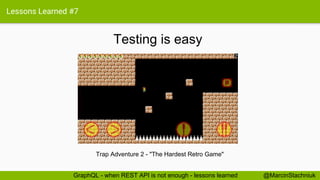GraphQL - when REST API is to less - lessons learned
- 1. GraphQL - when REST API is not enough - lessons learned Marcin Stachniuk 8 October 2018
- 3. Who is using REST? @MarcinStachniukGraphQL - when REST API is not enough - lessons learned
- 4. REST - REpresentational State Transfer https://api.example.com/customers/123 DELETE PUT POST GET PATCH @MarcinStachniukGraphQL - when REST API is not enough - lessons learned
- 5. REST fixed response GET /customers/111 { "customer": { "id": "111", "name": "John Doe", "email": "[email protected]", "company": { "id": "222" }, "orders": [ { "id": "333" }, { "id": "444" } ] } } { "customer": { "id": "111", "name": "John Doe", "email": "[email protected]", "company": { "href": "https://api.example.com/companies/222" }, "orders": [ { "href": "https://api.example.com/orders/333" }, { "href": "https://api.example.com/orders/444" } ] } } RE ST @MarcinStachniukGraphQL - when REST API is not enough - lessons learned
- 6. REST consequences: several roundtrips @MarcinStachniukGraphQL - when REST API is not enough - lessons learned
- 7. REST response with nested data GET /customers/111 { "customer": { "id": "111", "name": "John Doe", "email": "[email protected]", "company": { "id": "222", "name": "My Awesome Corporation", "website": "MyAwesomeCorporation.com" }, "orders": [ { "id": "333", "status": "delivered", "items": [ { "id": "555", "name": "Silver Bullet", "amount": "42", "price": "10000000", "currency": "USD", "producer": { "id": "777", "name": "Lorem Ipsum", "website": "LoremIpsum.com" } } ] }, { "id": "444", "name": "Golden Hammer", "amount": "5", "price": "10000", "currency": "USD", "producer": { ... } } ] } } RE ST @MarcinStachniukGraphQL - when REST API is not enough - lessons learned
- 8. REST response with nested data and limit fields GET /customers/111?fields=name,company/*,orders.status,orders.items(name,producer/name) { "customer": { "id": "111", "name": "John Doe", "email": "[email protected]", "company": { "id": "222", "name": "My Awesome Corporation", "website": "MyAwesomeCorporation.com" }, "orders": [ { "id": "333", "status": "delivered", "items": [ { "id": "555", "name": "Silver Bullet", "amount": "42", "price": "10000000", "currency": "USD", "producer": { "id": "777", "name": "Lorem Ipsum", "website": "LoremIpsum.com" } } ] }, { "id": "444", "name": "Golden Hammer", "amount": "5", "price": "10000", "currency": "USD", "producer": { ... } } ] } } RE ST @MarcinStachniukGraphQL - when REST API is not enough - lessons learned
- 9. Different clients - different needs /web /iphone /android /tv Application Web iPhone Android TV RE ST @MarcinStachniukGraphQL - when REST API is not enough - lessons learned
- 10. Different clients - different needs /web /iphone /android /tv Application Web iPhone Android TV Content-Type: application/vnd.myawesomecorporation.com+v1+web+json iphone android tv RE ST @MarcinStachniukGraphQL - when REST API is not enough - lessons learned
- 11. Different clients - different needs /web /iphone /android /tv Application Web iPhone Android TV Content-Type: application/vnd.myawesomecorporation.com+v1+web+json iphone android tv RE ST @MarcinStachniukGraphQL - when REST API is not enough - lessons learned
- 12. Platform Architecture Platform App 1 App 2 Customer App X... @MarcinStachniukGraphQL - when REST API is not enough - lessons learned
- 13. Modularisation at UI @MarcinStachniukGraphQL - when REST API is not enough - lessons learned
- 14. New Frontend Framework ReactJS Relay GraphQL TypeScript @MarcinStachniukGraphQL - when REST API is not enough - lessons learned
- 15. GraphQL ● Graph Query Language ● Published by Facebook in 2015 ● Growth from Facebook Graph API ● Reference implementation in JavaScript ● First version of Java Library: 18 Jul 2015 https://github.com/graphql-java/graphql-java ● First usage: 21 Sep 2015 @MarcinStachniukGraphQL - when REST API is not enough - lessons learned
- 16. Lessons Learned #1 Never add a library to your project few days after init release @MarcinStachniukGraphQL - when REST API is not enough - lessons learned ● No community ● A lot of bugs ● Bad documentation ● Strict following reference implementation and specification DO NOT TRY THIS AT WORK
- 17. GraphQL main concepts ● One endpoint for all operations ● Always define in request what you need ● Queries, Mutations and Subscriptions ● Defined by schema @MarcinStachniukGraphQL - when REST API is not enough - lessons learned
- 18. Data is a graph @MarcinStachniukGraphQL - when REST API is not enough - lessons learned
- 19. GraphQL Simple API GET /customers/2?fields=id,name,email type Customer { #fields with ! are not null id: ID! name: String! email: String! } type Query { customer(id: String!): Customer! } { "data": { "customer": { "id": "2", "name": "name", "email": "[email protected]" } } } { customer(id: "2") { id name email } } RE ST @MarcinStachniukGraphQL - when REST API is not enough - lessons learned
- 20. GraphQL Bad Request GET /custo!@#$ -> 404 { "data": null, "errors": [ { "message": "Invalid Syntax", "locations": [ { "line": 2, "column": 8 } ], "errorType": "InvalidSyntax", "path": null, "extensions": null } ] } { custo!@#$ } RE ST http.cat/200 @MarcinStachniukGraphQL - when REST API is not enough - lessons learned
- 21. Go back to the roots @MarcinStachniukGraphQL - when REST API is not enough - lessons learned
- 22. GraphQL Simple API GET /customers/2?fields=id,name,email,company(id,name) type Customer { id: ID! name: String! email: String! company: Company } type Company { id: ID! name: String! website: String! } type Query { customer(id: String!): Customer! } { "data": { "customer": { "id": "2", "name": "name", "email": "[email protected]", "company": { "id": "211", "name": "Company Corp." } } } } { customer(id: "2") { id name email company { id name } } } RE ST @MarcinStachniukGraphQL - when REST API is not enough - lessons learned
- 23. GraphQL Simple API GET /customers/2?fields=id,name,email,orders(id,status) type Customer { id: ID! name: String! email: String! company: Company orders: [Order] } type Order { id: ID! status: Status } enum Status { NEW, CANCELED, DONE } { "data": { "customer": { "id": "2", "name": "name", "orders": [ { "id": "55", "status": "NEW" }, { "id": "66", "status": "DONE" } ] } } } { customer(id: "2") { id name orders { id status } } } RE ST @MarcinStachniukGraphQL - when REST API is not enough - lessons learned
- 24. How to implement DataFetcher for queries GET /customers/2?fields=id,name,email,orders(id,status) @Component public class CustomerFetcher extends PropertyDataFetcher<Customer> { @Autowired private CustomerService customerService; @Override public Customer get(DataFetchingEnvironment environment) { String id = environment.getArgument("id"); return customerService.getCustomerById(id); } } RE ST { customer(id: "2") { id name orders { id status } } } @MarcinStachniukGraphQL - when REST API is not enough - lessons learned
- 25. How to implement DataFetcher for queries GET /customers/2?fields=id,name,email,orders(id,status) public class Customer { private String id; private String name; private String email; // getters are not required } RE ST { customer(id: "2") { id name orders { id status } } } @MarcinStachniukGraphQL - when REST API is not enough - lessons learned public class OrderDataFetcher extends PropertyDataFetcher<List<Order>> { @Override public List<Order> get(DataFetchingEnvironment environment) { Customer source = environment.getSource(); String customerId = source.getId(); return orderService.getOrdersByCustomerId(customerId); } }
- 26. GraphQL mutations input CreateCustomerInput { name: String email: String clientMutationId: String! } type CreateCustomerPayload { customer: Customer clientMutationId: String! } type Mutation { createCustomer(input: CreateCustomerInput): CreateCustomerPayload! } { "data": { "createCustomer": { "customer": { "id": "40", }, "clientMutationId": "123" } } } POST /customers PUT /customers/123 DELETE /customers/123 PATCH /customers/123 mutation { createCustomer(input: { name: "MyName" email: "[email protected]" clientMutationId: "123" }) { customer { id } clientMutationId } } RE ST @MarcinStachniukGraphQL - when REST API is not enough - lessons learned
- 27. How to implement DataFetcher for mutations POST /customers PUT /customers/123 DELETE /customers/123 PATCH /customers/123 @Component public class CreateCustomersFetcher extends PropertyDataFetcher<CreateCustomersPayload> { @Override public CreateCustomerPayload get(DataFetchingEnvironment env) { Map<String, Object> input = env.getArgument("input"); String name = (String) input.get("name"); String email = (String) input.get("email"); String clientMutationId = (String) input.get("clientMutationId"); Customer customer = customerService.create(name, email); return new CreateCustomerPayload(customer, clientMutationId); } RE ST mutation { createCustomer(input: { name: "MyName" email: "[email protected]" clientMutationId: "123" }) { customer { id } clientMutationId } } @MarcinStachniukGraphQL - when REST API is not enough - lessons learned
- 28. Abstraction over GraphQL Java Our abstraction Data Fetcher 2 Inputs mapping to objects Schema definition Pagination ... Data Fetcher 1 Data Fetcher N... @MarcinStachniukGraphQL - when REST API is not enough - lessons learned
- 29. Lessons Learned #2 Abstraction is not good if you don’t understand how it works under the hood @MarcinStachniukGraphQL - when REST API is not enough - lessons learned ● Copy paste errors ● Wrong usage ● Hard to update to new version
- 30. GraphQL can do more! ● Variables ● Aliases ● Fragments ● Operation name ● Directives ● Interfaces ● Unions @MarcinStachniukGraphQL - when REST API is not enough - lessons learned
- 31. GraphQL type system How to define your schema? @MarcinStachniukGraphQL - when REST API is not enough - lessons learned
- 32. Code First approach private GraphQLFieldDefinition customerDefinition() { return GraphQLFieldDefinition.newFieldDefinition() .name("customer") .argument(GraphQLArgument.newArgument() .name("id") .type(new GraphQLNonNull(GraphQLString))) .type(new GraphQLNonNull(GraphQLObjectType.newObject() .name("Customer") .field(GraphQLFieldDefinition.newFieldDefinition() .name("id") .description("fields with ! are not null") .type(new GraphQLNonNull(GraphQLID)) .build()) …. .build())) .dataFetcher(customerFetcher) .build(); } Schema First approach type Query { customer(id: String!): Customer! } type Customer { #fields with ! are not null id: ID! name: String! email: String! company: Company orders: [Order] } @MarcinStachniukGraphQL - when REST API is not enough - lessons learned
- 33. Code First approach - How to build Introspection query Introspection response Replace Relay definitions @MarcinStachniukGraphQL - when REST API is not enough - lessons learned Typescript relay plugin
- 34. Schema First approach type Customer { # fields with ! are required id: ID! name: String! email: String! company: Company orders: [Order] } *.graphqls SchemaParser schemaParser = new SchemaParser(); File file = // ... TypeDefinitionRegistry registry = schemaParser.parse(file); SchemaGenerator schemaGenerator = new SchemaGenerator(); RuntimeWiring runtimeWiring = RuntimeWiring.newRuntimeWiring() .type("Query", builder -> builder.dataFetcher("customer", customerFetcher)) // ... .build(); return schemaGenerator.makeExecutableSchema(registry, runtimeWiring); @MarcinStachniukGraphQL - when REST API is not enough - lessons learned
- 35. Schema First approach - project building diagram model.graphqls @MarcinStachniukGraphQL - when REST API is not enough - lessons learned
- 36. Lessons Learned #3 Schema First Approach is better Schema First Approach: ● Easy to maintain and understand ● Helps organise work ● Demo schema is 2x smaller Code First approach: ● Hard to maintain ● It was the only way at the beginning to define a schema ● No possibility to mix both ● No easy way to migrate to Schema First @MarcinStachniukGraphQL - when REST API is not enough - lessons learned
- 37. From Code First to Schema First migration https://github.com/mstachniuk/graphql-schema-from-introspection-generator @MarcinStachniukGraphQL - when REST API is not enough - lessons learned
- 38. GraphQL - How to define pagination, filtering, sorting? Pagination: ● before, after ● offset, limit Filtering: ● filter(name: “Bob” email: “%@gmail.com”) ● filter: { OR: [{ email: “%@gmail.com” }] }, name: “Bob” } Sorting: ● orderBy: ASC, DESC ● sort: NEWEST, IMPORTANCE @MarcinStachniukGraphQL - when REST API is not enough - lessons learned
- 39. Lessons Learned #4 GraphQL is not full query language @MarcinStachniukGraphQL - when REST API is not enough - lessons learned ● Flexibility ● Less common conventions ● Dgraph.io created GraphQL+-
- 40. GraphQL downsides @MarcinStachniukGraphQL - when REST API is not enough - lessons learned
- 41. GraphQL downsides: N+1 problem { customers { 1 call id name orders { n calls id status } } } java-dataloader ● Add async BatchLoader ● Add caching @MarcinStachniukGraphQL - when REST API is not enough - lessons learned
- 42. Lessons Learned #5 If you have N + 1 problem use java-dataloader @MarcinStachniukGraphQL - when REST API is not enough - lessons learned
- 43. GraphQL downsides: Bad GraphQL API definition - examples { customer(id: "2") { … } customerFull(id: "2") { … } customerFull2(id: "2") { … } customerWithDetails(id: "2") { … } ... } @MarcinStachniukGraphQL - when REST API is not enough - lessons learned { customer(id: "2") { id name orders { id status } } }
- 44. GraphQL downsides: Bad GraphQL API definition - examples { usersOrGroups(id: "123") { ... on User { id userName } ... on UserGroup { id name } } } { user(id: "123") { id userName } userGroup(id: "123") { id userName } } @MarcinStachniukGraphQL - when REST API is not enough - lessons learned
- 45. GraphQL downsides: Bad GraphQL API definition - examples { orders (input: { status: "NEW" first: "2" offset: "3" }, first: "1", offset: "3") { Items { … } } @MarcinStachniukGraphQL - when REST API is not enough - lessons learned
- 46. Lessons Learned #6 Thinking shift is a key @MarcinStachniukGraphQL - when REST API is not enough - lessons learned ● Let’s think in graphs and NOT in endpoints / resources / entities / DTOs ● Bad design of our API
- 47. GraphQL Testing @MarcinStachniukGraphQL - when REST API is not enough - lessons learned
- 48. Testing GraphQL @SpringBootTest @ContextConfiguration(classes = Main) class CustomerFetcherSpec extends Specification { @Autowired GraphQLSchema graphQLSchema GraphQL graphQL def setup() { graphQL = GraphQL.newGraphQL(graphQLSchema).build() } @MarcinStachniukGraphQL - when REST API is not enough - lessons learned
- 49. Testing GraphQL def "should get customer by id"() { given: def query = """{ customer(id: "2") { … } }""" def expected = [ "customer": [ … ] ] when: def result = graphQL.execute(query) then: result.data == expected } @MarcinStachniukGraphQL - when REST API is not enough - lessons learned
- 50. Lessons Learned #7 Testing is easy @MarcinStachniukGraphQL - when REST API is not enough - lessons learned Trap Adventure 2 - "The Hardest Retro Game"
- 51. Tools @MarcinStachniukGraphQL - when REST API is not enough - lessons learned
- 52. Tools GraphiQL @MarcinStachniukGraphQL - when REST API is not enough - lessons learned
- 53. Tools Relay @MarcinStachniukGraphQL - when REST API is not enough - lessons learned @MarcinStachniukGraphQL - when REST API is not enough - lessons learned user(...) { photo(width: "120", height: "120") } user(...) { name } user(...) { email } user(...) { name email photo(width: "120", height: "120") }
- 54. Distelli/graphql-apigen https://github.com/Distelli/graphql-apigen Generate Java APIs with GraphQL Schemas in order to facilitate "schema first" development. @MarcinStachniukGraphQL - when REST API is not enough - lessons learned
- 55. GraphQL Java Tools https://github.com/graphql-java/graphql-java-tools Map GraphQL schema to POJOs @MarcinStachniukGraphQL - when REST API is not enough - lessons learned
- 56. More libraries and projects related to graphql-java https://github.com/graphql-java/awesome-graphql-java @MarcinStachniukGraphQL - when REST API is not enough - lessons learned ● Generates a GraphQL schema from a JDBC data source ● Annotations-based syntax for GraphQL schema definition ● JPA Implementation of GraphQL (builds on graphql-java) ● And more examples
- 57. Apollo @MarcinStachniukGraphQL - when REST API is not enough - lessons learned Build a universal GraphQL API on top of your existing REST APIs, so you can ship new application features fast without waiting on backend changes.
- 58. Lessons Learned #8 Tooling is nice @MarcinStachniukGraphQL - when REST API is not enough - lessons learned now
- 59. Summary GraphQL Pros: ● Nice alternative to REST ● It can be used together with REST ● Good integration with Relay / ReactJS ● You get exactly what you want to get ● Good for API with different clients ● Good to use on top of existing API ● Self documented ● Easy testing ● Nice tooling GraphQL Cons: ● High entry barrier ● Hard to return simple Map ● Not well know (yet) ● Performance overhead ● A lot of similar code to write @MarcinStachniukGraphQL - when REST API is not enough - lessons learned
- 60. Nothing is a silver bullet @MarcinStachniukGraphQL - when REST API is not enough - lessons learned
- 61. Q&A @MarcinStachniukGraphQL - when REST API is not enough - lessons learned
- 62. Feedback @MarcinStachniukGraphQL - when REST API is not enough - lessons learned
- 63. GraphQL - when REST API is not enough - lessons learned Marcin Stachniuk 8 October 2018 Thank you!





![REST fixed response
GET /customers/111
{
"customer": {
"id": "111",
"name": "John Doe",
"email": "john@doe.com",
"company": {
"id": "222"
},
"orders": [
{
"id": "333"
},
{
"id": "444"
}
]
}
}
{
"customer": {
"id": "111",
"name": "John Doe",
"email": "john@doe.com",
"company": {
"href": "https://api.example.com/companies/222"
},
"orders": [
{
"href": "https://api.example.com/orders/333"
},
{
"href": "https://api.example.com/orders/444"
}
]
}
}
RE
ST
@MarcinStachniukGraphQL - when REST API is not enough - lessons learned](https://image.slidesharecdn.com/jddgraphql-whenrestapiistoless-lessonslearned-181008141925/85/GraphQL-when-REST-API-is-to-less-lessons-learned-5-320.jpg)

![REST response with nested data
GET /customers/111
{
"customer": {
"id": "111",
"name": "John Doe",
"email": "john@doe.com",
"company": {
"id": "222",
"name": "My Awesome Corporation",
"website": "MyAwesomeCorporation.com"
},
"orders": [
{
"id": "333",
"status": "delivered",
"items": [
{
"id": "555",
"name": "Silver Bullet",
"amount": "42",
"price": "10000000",
"currency": "USD",
"producer": {
"id": "777",
"name": "Lorem Ipsum",
"website": "LoremIpsum.com"
}
}
]
},
{
"id": "444",
"name": "Golden Hammer",
"amount": "5",
"price": "10000",
"currency": "USD",
"producer": {
...
}
}
] } }
RE
ST
@MarcinStachniukGraphQL - when REST API is not enough - lessons learned](https://image.slidesharecdn.com/jddgraphql-whenrestapiistoless-lessonslearned-181008141925/85/GraphQL-when-REST-API-is-to-less-lessons-learned-7-320.jpg)
![REST response with nested data and limit fields
GET /customers/111?fields=name,company/*,orders.status,orders.items(name,producer/name)
{
"customer": {
"id": "111",
"name": "John Doe",
"email": "john@doe.com",
"company": {
"id": "222",
"name": "My Awesome Corporation",
"website": "MyAwesomeCorporation.com"
},
"orders": [
{
"id": "333",
"status": "delivered",
"items": [
{
"id": "555",
"name": "Silver Bullet",
"amount": "42",
"price": "10000000",
"currency": "USD",
"producer": {
"id": "777",
"name": "Lorem Ipsum",
"website": "LoremIpsum.com"
}
}
]
},
{
"id": "444",
"name": "Golden Hammer",
"amount": "5",
"price": "10000",
"currency": "USD",
"producer": {
...
}
}
] } }
RE
ST
@MarcinStachniukGraphQL - when REST API is not enough - lessons learned](https://image.slidesharecdn.com/jddgraphql-whenrestapiistoless-lessonslearned-181008141925/85/GraphQL-when-REST-API-is-to-less-lessons-learned-8-320.jpg)











![GraphQL Bad Request
GET /custo!@#$ -> 404
{
"data": null,
"errors": [
{
"message": "Invalid Syntax",
"locations": [
{
"line": 2,
"column": 8
}
],
"errorType": "InvalidSyntax",
"path": null,
"extensions": null
} ] }
{
custo!@#$
}
RE
ST
http.cat/200
@MarcinStachniukGraphQL - when REST API is not enough - lessons learned](https://image.slidesharecdn.com/jddgraphql-whenrestapiistoless-lessonslearned-181008141925/85/GraphQL-when-REST-API-is-to-less-lessons-learned-20-320.jpg)


![GraphQL Simple API
GET /customers/2?fields=id,name,email,orders(id,status)
type Customer {
id: ID!
name: String!
email: String!
company: Company
orders: [Order]
}
type Order {
id: ID!
status: Status
}
enum Status {
NEW, CANCELED, DONE
}
{
"data": {
"customer": {
"id": "2",
"name": "name",
"orders": [
{
"id": "55",
"status": "NEW"
},
{
"id": "66",
"status": "DONE"
}
] } } }
{
customer(id: "2") {
id
name
orders {
id
status
}
}
}
RE
ST
@MarcinStachniukGraphQL - when REST API is not enough - lessons learned](https://image.slidesharecdn.com/jddgraphql-whenrestapiistoless-lessonslearned-181008141925/85/GraphQL-when-REST-API-is-to-less-lessons-learned-23-320.jpg)








![Code First approach
private GraphQLFieldDefinition customerDefinition() {
return GraphQLFieldDefinition.newFieldDefinition()
.name("customer")
.argument(GraphQLArgument.newArgument()
.name("id")
.type(new GraphQLNonNull(GraphQLString)))
.type(new GraphQLNonNull(GraphQLObjectType.newObject()
.name("Customer")
.field(GraphQLFieldDefinition.newFieldDefinition()
.name("id")
.description("fields with ! are not null")
.type(new GraphQLNonNull(GraphQLID))
.build())
….
.build()))
.dataFetcher(customerFetcher)
.build();
}
Schema First approach
type Query {
customer(id: String!): Customer!
}
type Customer {
#fields with ! are not null
id: ID!
name: String!
email: String!
company: Company
orders: [Order]
}
@MarcinStachniukGraphQL - when REST API is not enough - lessons learned](https://image.slidesharecdn.com/jddgraphql-whenrestapiistoless-lessonslearned-181008141925/85/GraphQL-when-REST-API-is-to-less-lessons-learned-32-320.jpg)

![Schema First approach
type Customer {
# fields with ! are required
id: ID!
name: String!
email: String!
company: Company
orders: [Order]
}
*.graphqls
SchemaParser schemaParser = new SchemaParser();
File file = // ...
TypeDefinitionRegistry registry = schemaParser.parse(file);
SchemaGenerator schemaGenerator = new SchemaGenerator();
RuntimeWiring runtimeWiring = RuntimeWiring.newRuntimeWiring()
.type("Query", builder ->
builder.dataFetcher("customer", customerFetcher))
// ...
.build();
return schemaGenerator.makeExecutableSchema(registry, runtimeWiring);
@MarcinStachniukGraphQL - when REST API is not enough - lessons learned](https://image.slidesharecdn.com/jddgraphql-whenrestapiistoless-lessonslearned-181008141925/85/GraphQL-when-REST-API-is-to-less-lessons-learned-34-320.jpg)



![GraphQL - How to define pagination, filtering, sorting?
Pagination:
● before, after
● offset, limit
Filtering:
● filter(name: “Bob” email: “%@gmail.com”)
● filter: {
OR: [{
email: “%@gmail.com”
}]
}, name: “Bob”
}
Sorting:
● orderBy: ASC, DESC
● sort: NEWEST, IMPORTANCE
@MarcinStachniukGraphQL - when REST API is not enough - lessons learned](https://image.slidesharecdn.com/jddgraphql-whenrestapiistoless-lessonslearned-181008141925/85/GraphQL-when-REST-API-is-to-less-lessons-learned-38-320.jpg)










![Testing GraphQL
def "should get customer by id"() {
given:
def query = """{ customer(id: "2") { … } }"""
def expected = [ "customer": [ … ] ]
when:
def result = graphQL.execute(query)
then:
result.data == expected
}
@MarcinStachniukGraphQL - when REST API is not enough - lessons learned](https://image.slidesharecdn.com/jddgraphql-whenrestapiistoless-lessonslearned-181008141925/85/GraphQL-when-REST-API-is-to-less-lessons-learned-49-320.jpg)
















![[DevCrowd] GraphQL - gdy API RESTowe to za mało](https://cdn.slidesharecdn.com/ss_thumbnails/devcrowdgraphql-whenrestapiistoless-lessonslearned-190629075627-thumbnail.jpg?width=560&fit=bounds)






































![[WroclawJUG] Continuous Delivery in OSS using Shipkit](https://cdn.slidesharecdn.com/ss_thumbnails/continuousdeliverywoss1-190403074306-thumbnail.jpg?width=560&fit=bounds)





































